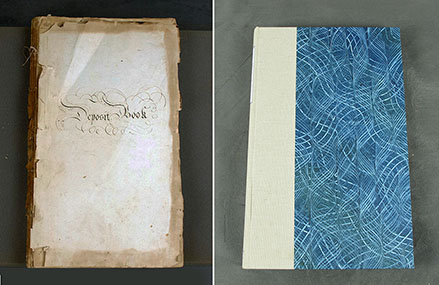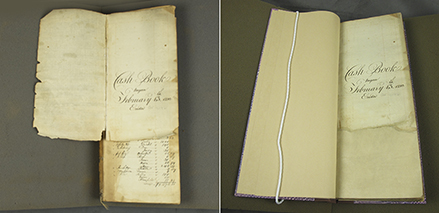In my previous blog post about rebinding ledgers from the Bank of North America collection, I described the Split Board binding process we use on books with bindings that have deteriorated. This binding uses an inside cloth hinge to reattach the original cover boards. We use this rebinding method the most because it gives the books new life without changing much of the original look. However some books in the collection that are missing both the front and back covers, or the severe deterioration of the existing covers require creating a new case. So far we have found 10 volumes with missing covers in the Bank of North America Collection and have rebound them. In this blog post, I would like to share how we have rebound and recased those volumes with the Bradel Binding.
The Bradel Binding is a type of case binding in which the case (the covers and spine) is created separately and later attached to the sewn text block. The distinctiveness of the Bradel Binding is that it is composed of two cover boards and a thin spine stiffener that are joined together with a strip of strong paper before the case is covered with book cloth. This lets the case fit precisely to the text block, especially at the joint (the hinge where the covers meet the spine) and fore-edge (the side the book opens). The Bradel Binding is also often considered to be stronger than other case bindings.
Below are some before and after examples of the Bradel Binding treatment. The spine and joints are covered with paper-backed book cloth, and the front and back boards are covered with decorative papers — such as the paste paper that we make here in the Conservation Lab at HSP.
Missing covers/spine and the new case
All split apart text block and the rebound text block
Missing front cover and the new front cover
Torn and missing end papers and newly created/mended end papers
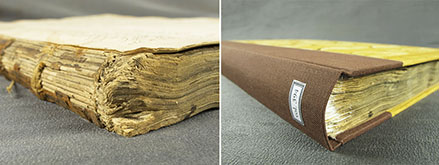
Missing spine and the new spine
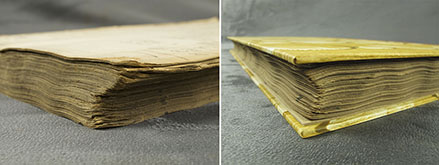
Detail views of fore-edge before and after treatment
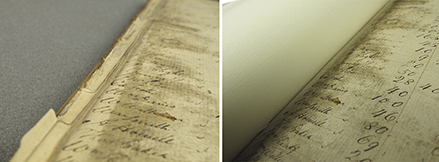
Details of the first page of the book with missing end paper and newly created end papr
Now, the following images are going to show the brief process of how we rebind the text block and reconstruct the case with using Bradel Binding.
As we start the other rebinding process (Split Board Binding), we first have to clean and take apart the badly detariorated old binding that doesn't function properly. Then we reinforce the pages with guarding each section and mending each tear and flatten the sections for sewing. Also, we create end papers that have been missing in the most of these books. Those end papers have the long strip of cotton flap (hinge) attached to adhere this text block to the new case later.


The guarded sections are being punched for sewing.

Text block is being sewn onto linen tapes.

Text block is ready to be rounded (detal view of sewing and cotton hinges).

Text block is being rounded in the finishing press.

(Detail view of the rounded spine)

Spine surface is being covered with layers of thin paper in between the linen tapes.

Text block is all prepared.

Jig is created prior to constructing the whole new case with using small scrap pieces of the materials.

According to the measurment of the jig, the new case is created.

Sometime, more than one jig created for one book to make more prescise case.

Two boards and one spine piece are joined together on a strip of a sturdy paper.

The spine and joint area are covered with book cloth.

The two boards are covered with decorative paste paper.

The case and the text block are all prepared saperately.

The newly bound text block is ready to be cased in.

The cotton hinges and the linen tapes are all adhered to the front and back boards and create very strong but flexible joints.

Cased in!!

(Detail views of the spine head and inner hinge)
For more images of before and after treatment can be found on Flickr photostream.




